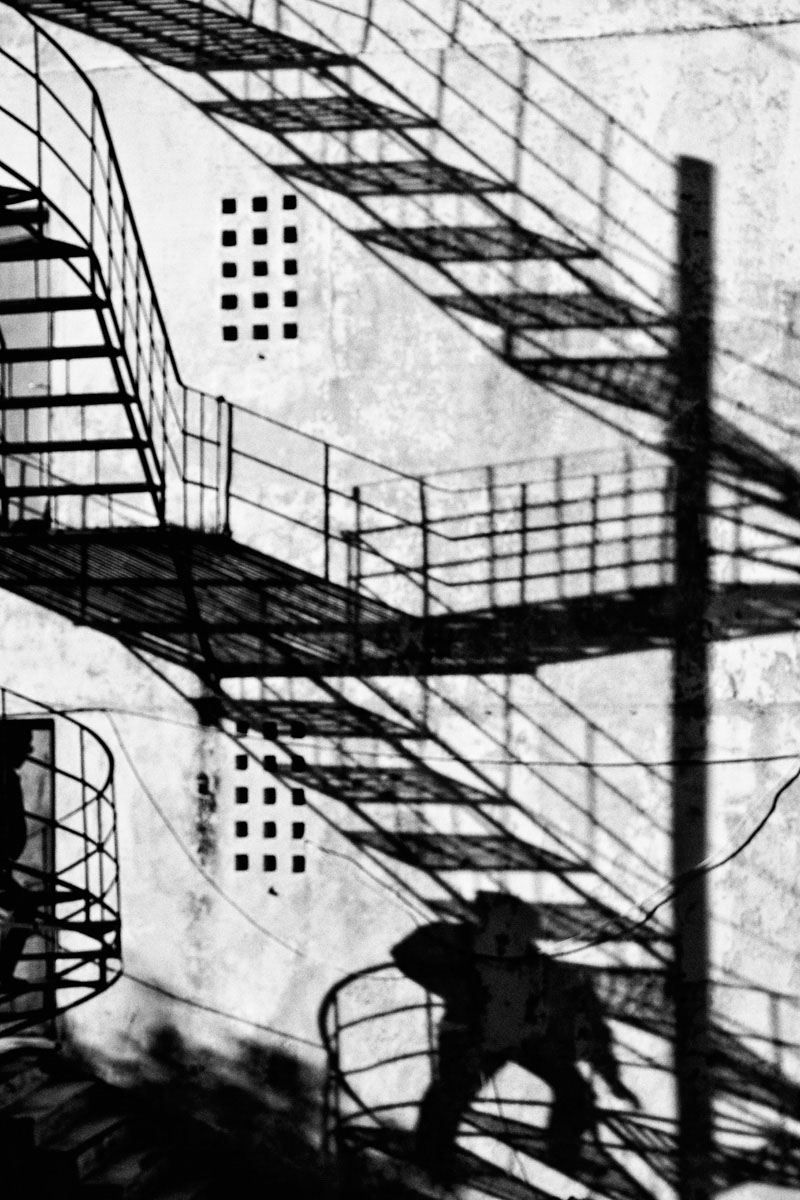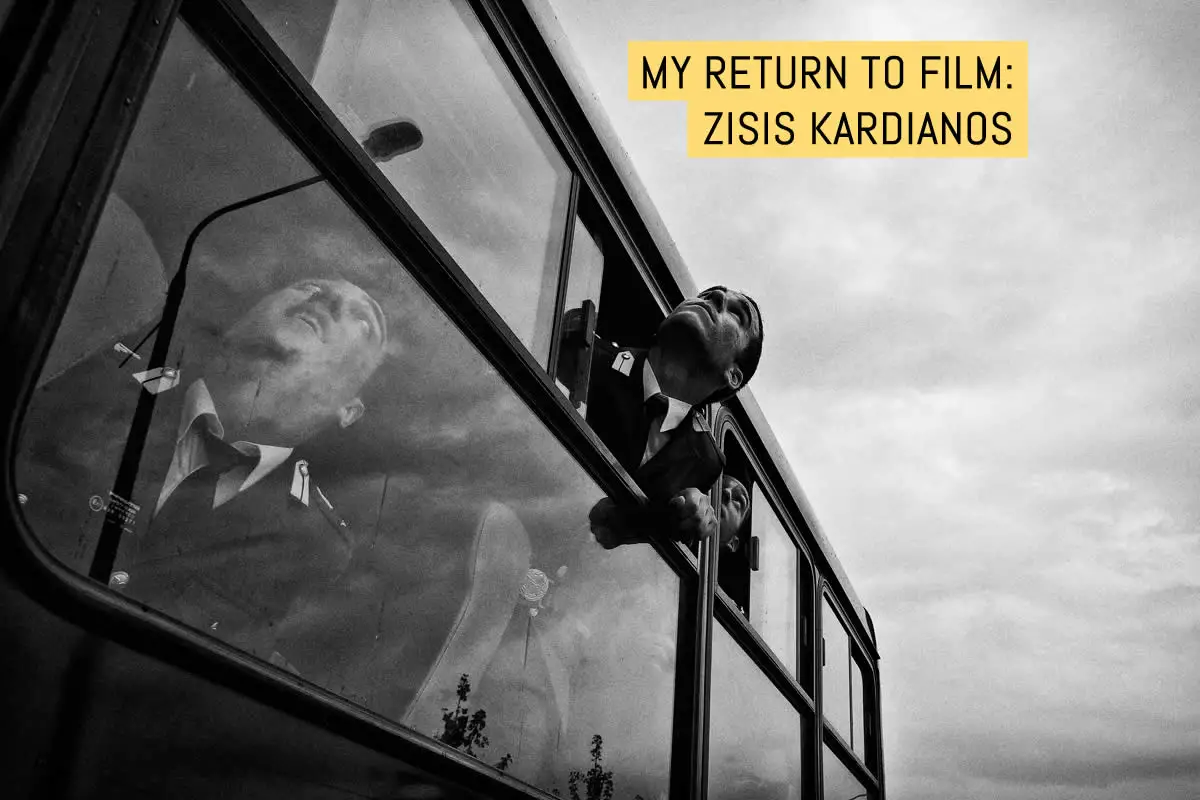I came back to shooting film three years ago in 2017. For the previous fifteen years I had been shooting digital with a range of cameras, the last one being the Fuji X-T1, which I still use randomly or for special assignments. It is a fine, elegant and reliable machine and the results I was getting from this, enhanced by applying the brilliant Fuji colour profiles that resemble old Fuji film stock, were both consistent and appealing.
However, I gradually began to feel that there was something missing, both in terms of the results themselves and in terms of my emotional connection with the photographic process and my subjects.
I have always been a photographer who is eager to try my hand at different types or genres of photography and I was never really concerned about establishing an identifiable style, which I saw as a threat to my creativity and the pleasure I was getting from photography. Though I must admit that I owe some of my most treasured pictures to digital.








My first camera back in the 80s was a Minolta X-700 always loaded with ILFORD HP5, making street and social documentary work as part of my two-year studies in photography in a newly founded photography school in Athens. After five years of intensive photography, life got in the way and I stopped shooting all-together. I never really stopped to wonder why or how it happened.
Up until then, I’d thought that I had a healthy and rewarding experience with the medium of photography. It was another, rather life-changing experience that brought me back to photography several years later, a reconciliation that owed a big part to the convenience of shooting with a digital camera.



Fast-forward to the present. After having bought and returned, borrowed and tested several medium format and 35mm cameras during the last three years, I can safely say that I have settled on using the Bronica ETRSi and the Minolta Dynax 7 – also known as the Maxxum 7 in the US and the Minolta a7 in Japan – for the foreseeable future.
These are two completely different cameras that serve different purposes. Other than the obvious difference that the one is a medium format camera and the other a 35mm, they have at least three things in common. They are both SLRs, they both produce stunning results and they are both hugely underrated machines compared to their more hyped — and expensive – counterparts.
Even though we can all agree that the camera alone doesn’t make the photographer, I’m not the only one who believes that an occasional change of tools can yield a different approach and different results. That’s why, upon my planned return to film, I made the conscious decision to upgrade to a medium format camera that would slow me down and make my method more deliberate. After a lot of online research and self-reflection, I decided that my go-to camera would be the Bronica RF645, a rangefinder camera as the “RF” designates, also described as the poor person’s Mamiya 7.
I bought a mint copy from a friend on Facebook. The camera was very nice, easy to carry around and hold, but it turned out that I wasn’t suited for achieving pin-sharp images with that dim rangefinder patch. As a result, half of my shots were more or less out of focus and soft (though thankfully not all of them).




After a new round of research and contemplation, I concluded that my dream camera was the Bronica GS-1. Besides holding the Bronica brand in high esteem, its models, lenses and accessories are easy to find and reasonably priced. To my great disappointment and frustration, I wasn’t lucky with either of the two copies I bought from different sellers through eBay; after somehow exposing half a roll, however, I was able to see what this camera and lenses were capable of, if only they were functioning as it should.


After significant time had been lost along with some money along the way, I decided to move forward and look for something else. And then came the Bronica (of course! what else?) ETRSi, complete with two top-of-the-line PE lenses, AE prism finder, auto winder and grip.
Mint copy, fully functional, clear sharp lenses and finder. Even though it’s a mid-range medium format 6×4.5 camera, when fully dressed up with all the bells and whistles, it can get bulky and heavy to carry around for long. However truth be told, it’s a camera that gives you the best of both worlds: portability and a more slowed-down approach to picture-making.
In due time, I’m planning to set up a darkroom for both developing my own films and wet printing. At the moment, I only do the scanning at home with an Epson Perfection V500 Photo scanner which does a decent job but I’m thinking of replacing it with a more advanced model. By doing the scanning myself, I have managed to substantially reduce the cost of using film.




I still have my old Minolta X-700. After taking it out for some test shooting, both anxious and hopeful to see how it has aged, whether time has treated it well — because I definitely haven’t — I found, not to my great surprise, that it suffers from a sticky shutter. That fact in conjunction with an irresistible itch to acquire a specific 35mm camera long part of my nostalgia-triggered wish list, led me to buy the brilliant Minolta Dynax 7.
I remember when the Dynax 7 first came out in 2000. Despite its high-end optics and innovations and despite having one of the most advanced user interfaces ever featured in an autofocus SLR camera, it was looked upon as a thing of the past. Minolta still doesn’t get the respect it deserves from fellow photographers. I bought the camera about a month ago and when I hold it in my hands and looked through the viewfinder, I just knew that this was the real deal; I fell in love with it instantly. So far I have only shot 3 rolls with it in different situations, day and night and I’m amazed by its responsiveness, ease of use, user interface and image quality.





I mostly like to work in series of images or projects and one of the projects I’ve been working on when I started using film again, is documenting the present state of Pireos Street in a part of Athens that was once an area full of factories and small scale industries. During the 50s and all the way through the 70s, it was the epicentre of industrial activity in Greece, a part of Athens’ urban web. The photographs from the Minolta I’m showing here are a small sample from this ongoing project.
Thanks for reading.
~ Zisis
Share your knowledge, story or project
The transfer of knowledge across the film photography community is the heart of EMULSIVE. You can add your support by contributing your thoughts, work, experiences and ideas to inspire the hundreds of thousands of people who read these pages each month. Check out the submission guide here.
If you like what you’re reading you can also help this passion project by heading over to the EMULSIVE Patreon page and contributing as little as a dollar a month. There’s also print and apparel over at Society 6, currently showcasing over two dozen t-shirt designs and over a dozen unique photographs available for purchase.








6 responses to “My return to film: Zisis Kardianos”
Nice photos! I agree with you about the Dynax 7. One of my favorite things to do when I share photos from mine is to tell the viewer that they were shot on a film camera. It’s scary how good that camera is and fun to watch heads explode when they see that film can be every bit as good (or better!) than digital.
Thank you Rob. I appreciate your comments. The 7 was my best analogue purchase by far for its price.
Great stuff, Zisis. Your next step should be a 35mm rangefinder, something like the Konica Hexar RF with a nice little 35mm/f2.5 Voigtlander lens. (The Leicas are nice but their price tags are not…)
Thanks Thodoris. The Hexar is on my wish list when the right time comes. I don’t know how the current virus and economic crisis will affect the prices of analogue gear. I suppose we will see some reductions to more reasonable levels.
Brilliant images.
Thank you Egil!